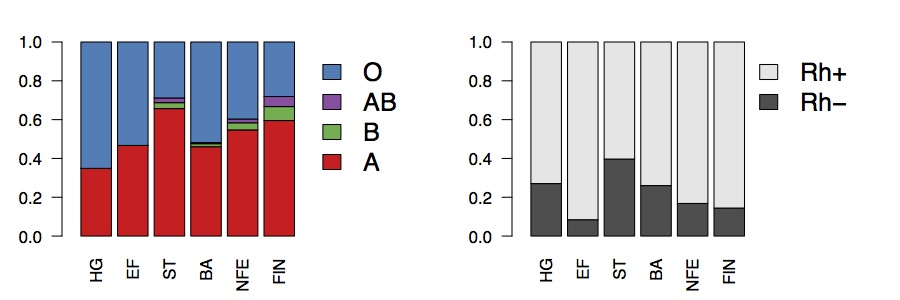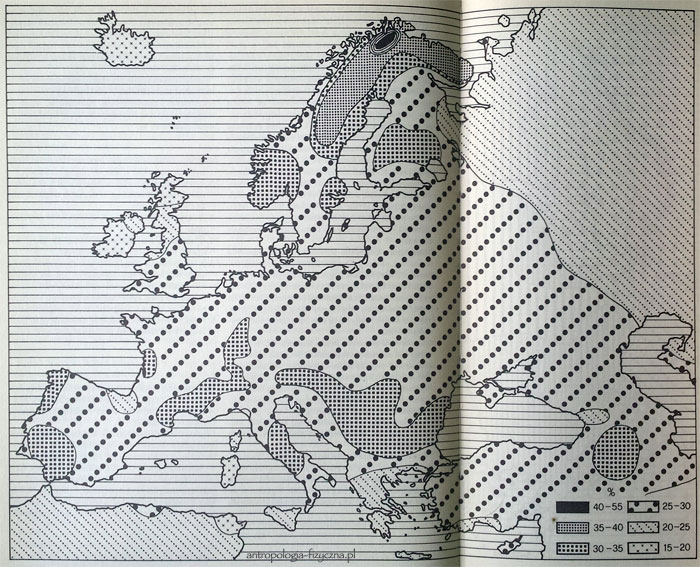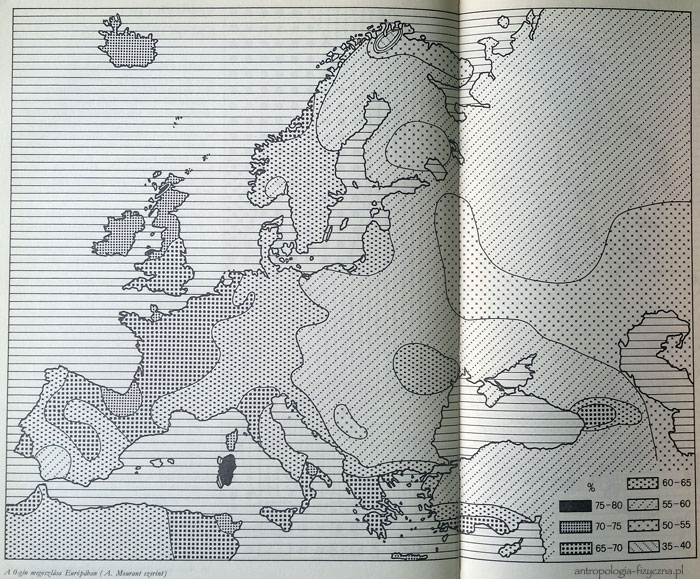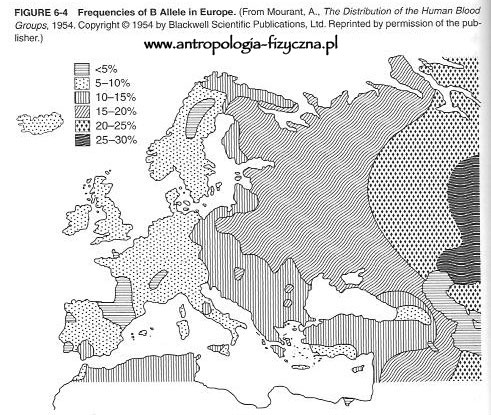Tomenable
Elite member
- Messages
- 5,419
- Reaction score
- 1,337
- Points
- 113
- Location
- Poland
- Ethnic group
- Polish
- Y-DNA haplogroup
- R1b-L617
- mtDNA haplogroup
- W6a
Rhesus:
Rh- was common in both Proto-Indo-Europeans and hunter-gatherers, but not in Neolithic farmers:
http://mathii.github.io/2017/09/21/blood-groups-in-ancient-europe
"(...) It turns out that the O allele is at high frequency in hunter-gatherers, but relatively rare on the Steppe. The B allele seems to be absent in both hunter-gatherers and early farmers, and seems to be introduced from the steppe in the Bronze Age. The Rh- allele seems to be relatively common in hunter-gatherers and, particularly, in steppe populations, and relatively rare in early farmers, partly confirming Haldane and Cavalli-Sforza’s hypotheses. Allele frequency estimates are in the figures below (bars show 95% binomial confidence intervals). (...)"
"(...) If we compute expected phenotypic frequencies, this suggests that around around 65% of Mesolithic hunter-gatherers would have been type O, compared to around 40% in present-day Europeans, and around 40% of Steppe-ancestry individuals would have been Rh-, compared to around 24% of hunter-gatherers, 4% of early farmers, and about 16% of present-day Europeans. (...)"
This is from Ian Mathieson:
https://twitter.com/mathiesoniain/status/911001882063142913

Rh blood groups in modern Europe (look at this high frequency of Rh- in Ukraine):
This maps shows frequencies of Rh+ (and low frequency of Rh+ = high of Rh-):

ABO:
Blood O is the most indigenous, blood B appears only after Indo-European invasions:
https://www.biorxiv.org/content/biorxiv/suppl/2017/09/19/135616.DC4/135616-1.pdf
From pages 53-54:
"We estimated allele frequencies at three markers that largely determine ABO blood group.14
The 1-base deletion rs8176719 that is the most common type O mutation is at high frequency
in hunter-gatherers. Combining all hunter-gatherer populations, we estimate the frequency of
the O allele to be 84% (95% CI: 76-89%), which implies that the frequency of the type O
phenotype which requires homozygosity for the O allele was 71%. This is significantly higher
than the O allele frequency in present-day Europeans (60-65% in 1000 Genomes populations,
with corresponding phenotype frequency ~40%). We do not detect the B allele (rs8176746 and rs8176747) in any hunter-gatherers suggesting that all other individuals were type A. In fact, the B allele is not seen in any Neolithic populations either, and is introduced into Europe by Steppe populations who we estimate carry it at ~8% frequency."
========
Indo-Europeans introduced B, but A was still much more common among them. On the other hand, O was relatively rare among them, and more commong among WHG hunters and EEF farmers.
This map shows the modern distribution of A allele in Europe:

O is the least Indo-European, associated with WHG and EEF:

Finally, modern frequencies of B allele in Western Eurasia:

Rh- was common in both Proto-Indo-Europeans and hunter-gatherers, but not in Neolithic farmers:
http://mathii.github.io/2017/09/21/blood-groups-in-ancient-europe
"(...) It turns out that the O allele is at high frequency in hunter-gatherers, but relatively rare on the Steppe. The B allele seems to be absent in both hunter-gatherers and early farmers, and seems to be introduced from the steppe in the Bronze Age. The Rh- allele seems to be relatively common in hunter-gatherers and, particularly, in steppe populations, and relatively rare in early farmers, partly confirming Haldane and Cavalli-Sforza’s hypotheses. Allele frequency estimates are in the figures below (bars show 95% binomial confidence intervals). (...)"
"(...) If we compute expected phenotypic frequencies, this suggests that around around 65% of Mesolithic hunter-gatherers would have been type O, compared to around 40% in present-day Europeans, and around 40% of Steppe-ancestry individuals would have been Rh-, compared to around 24% of hunter-gatherers, 4% of early farmers, and about 16% of present-day Europeans. (...)"
This is from Ian Mathieson:
https://twitter.com/mathiesoniain/status/911001882063142913

Rh blood groups in modern Europe (look at this high frequency of Rh- in Ukraine):
This maps shows frequencies of Rh+ (and low frequency of Rh+ = high of Rh-):

ABO:
Blood O is the most indigenous, blood B appears only after Indo-European invasions:
https://www.biorxiv.org/content/biorxiv/suppl/2017/09/19/135616.DC4/135616-1.pdf
From pages 53-54:
"We estimated allele frequencies at three markers that largely determine ABO blood group.14
The 1-base deletion rs8176719 that is the most common type O mutation is at high frequency
in hunter-gatherers. Combining all hunter-gatherer populations, we estimate the frequency of
the O allele to be 84% (95% CI: 76-89%), which implies that the frequency of the type O
phenotype which requires homozygosity for the O allele was 71%. This is significantly higher
than the O allele frequency in present-day Europeans (60-65% in 1000 Genomes populations,
with corresponding phenotype frequency ~40%). We do not detect the B allele (rs8176746 and rs8176747) in any hunter-gatherers suggesting that all other individuals were type A. In fact, the B allele is not seen in any Neolithic populations either, and is introduced into Europe by Steppe populations who we estimate carry it at ~8% frequency."
========
Indo-Europeans introduced B, but A was still much more common among them. On the other hand, O was relatively rare among them, and more commong among WHG hunters and EEF farmers.
This map shows the modern distribution of A allele in Europe:

O is the least Indo-European, associated with WHG and EEF:

Finally, modern frequencies of B allele in Western Eurasia:



